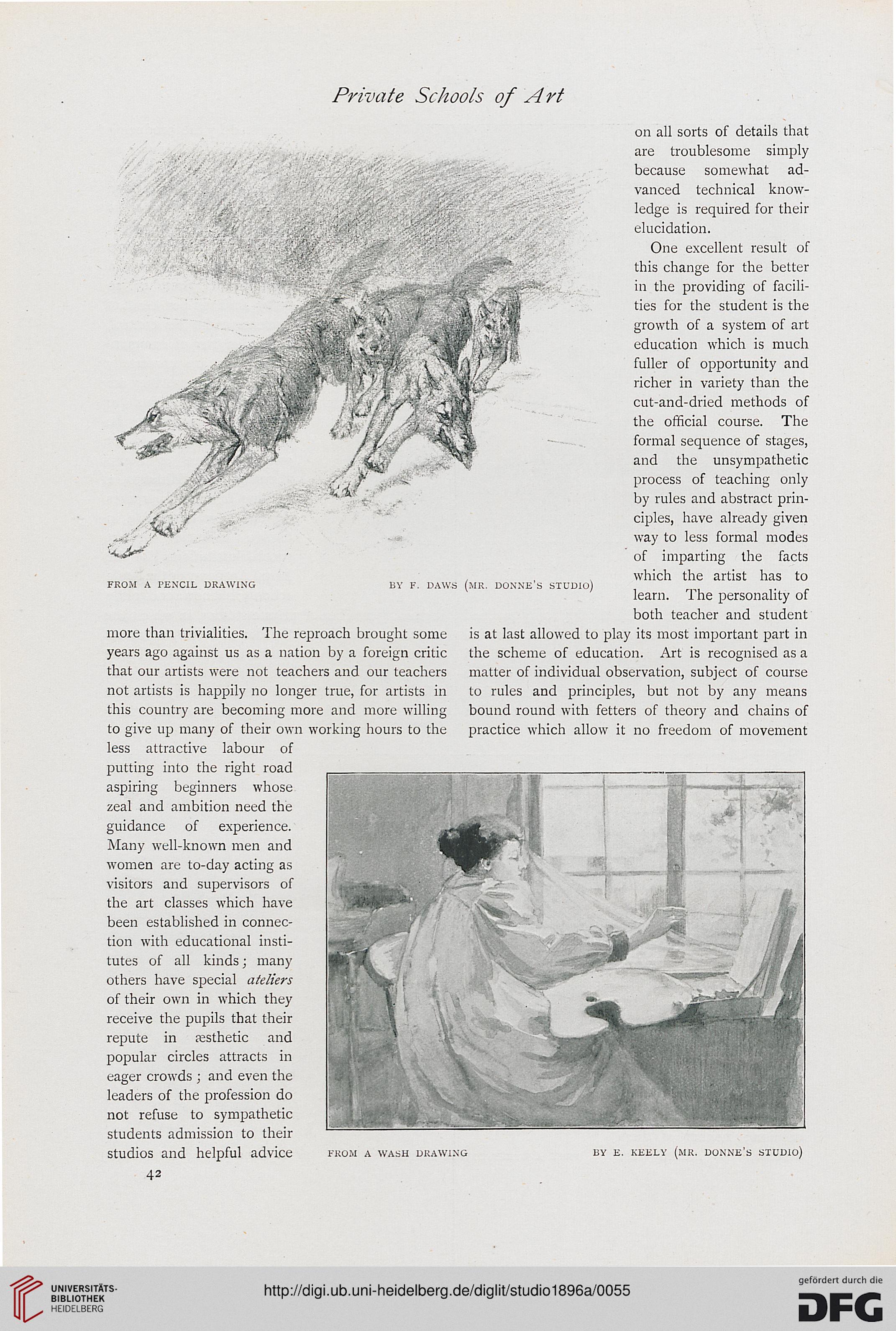Private Schools of Art
on all sorts of details that
are troublesome simply
because somewhat ad-
vanced technical know-
ledge is required for their
elucidation.
One excellent result of
this change for the better
in the providing of facili-
~% -vjfS^, &!?V$8 ties for the student is the
growth of a system of art
education which is much
fuller of opportunity and
richer in variety than the
cut-and-dried methods of
the official course. The
P**- *' J Yy ■ '^StSr'ljfe formal sequence of stages,
and the unsympathetic
process of teaching only
by rules and abstract prin-
ciples, have already given
way to less formal modes
'J*^c ' of imparting the facts
which the artist has to
from a pencil drawing by f. daws (.mr. donne s studio)
learn. The personality of
both teacher and student
more than trivialities. The reproach brought some is at last allowed to play its most important part in
years ago against us as a nation by a foreign critic the scheme of education. Art is recognised as a
that our artists were not teachers and our teachers matter of individual observation, subject of course
not artists is happily no longer true, for artists in to rules and principles, but not by any means
this country are becoming more and more willing bound round with fetters of theory and chains of
to give up many of their own working hours to the practice which allow it no freedom of movement
less attractive labour of
putting into the right road
aspiring beginners whose
zeal and ambition need the
guidance of experience.
Many well-known men and
women are to-day acting as
visitors and supervisors of
the art classes which have
been established in connec-
tion with educational insti-
tutes of all kinds; many
others have special ateliers
of their own in which they
receive the pupils that their
repute in aesthetic and
popular circles attracts in
eager crowds ; and even the
leaders of the profession do
not refuse to sympathetic
students admission to their
studios and helpful advice from a wash drawing uy e. keely (mr. donne's studio)
42
mm
on all sorts of details that
are troublesome simply
because somewhat ad-
vanced technical know-
ledge is required for their
elucidation.
One excellent result of
this change for the better
in the providing of facili-
~% -vjfS^, &!?V$8 ties for the student is the
growth of a system of art
education which is much
fuller of opportunity and
richer in variety than the
cut-and-dried methods of
the official course. The
P**- *' J Yy ■ '^StSr'ljfe formal sequence of stages,
and the unsympathetic
process of teaching only
by rules and abstract prin-
ciples, have already given
way to less formal modes
'J*^c ' of imparting the facts
which the artist has to
from a pencil drawing by f. daws (.mr. donne s studio)
learn. The personality of
both teacher and student
more than trivialities. The reproach brought some is at last allowed to play its most important part in
years ago against us as a nation by a foreign critic the scheme of education. Art is recognised as a
that our artists were not teachers and our teachers matter of individual observation, subject of course
not artists is happily no longer true, for artists in to rules and principles, but not by any means
this country are becoming more and more willing bound round with fetters of theory and chains of
to give up many of their own working hours to the practice which allow it no freedom of movement
less attractive labour of
putting into the right road
aspiring beginners whose
zeal and ambition need the
guidance of experience.
Many well-known men and
women are to-day acting as
visitors and supervisors of
the art classes which have
been established in connec-
tion with educational insti-
tutes of all kinds; many
others have special ateliers
of their own in which they
receive the pupils that their
repute in aesthetic and
popular circles attracts in
eager crowds ; and even the
leaders of the profession do
not refuse to sympathetic
students admission to their
studios and helpful advice from a wash drawing uy e. keely (mr. donne's studio)
42
mm




